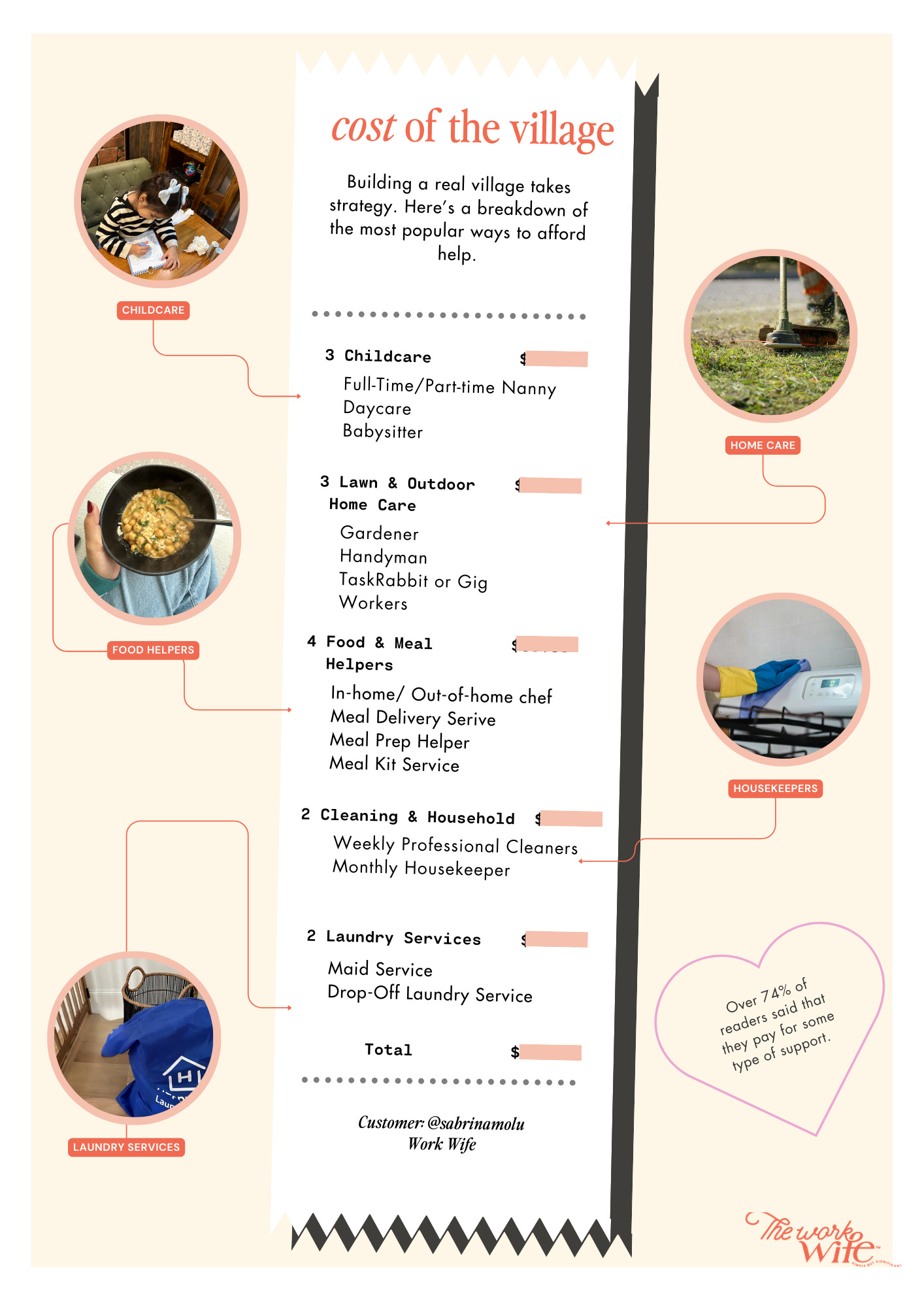This is part 2 of my multi-part series on The Village. Last week I explored friendships as new moms vs single friends and what it looks like from both angles. Today, I explore the dynamics of paid vs unpaid help, the costs associated, how to manage familiar help, and ways to get more affordable support.
Before I became a mom, my husband and I had *so many* conversations about what life would look like after kids. We talked about our careers, child care, the kind of help we’d need, and whether our parents would be involved. It felt good to have a plan.
And then real life happened, and most of that plan went out the window.
Luckily, I have *the best* community of over 200k women who share their experiences, and if there’s one thing I’ve learned, it’s that no one does this alone. Support, both paid and unpaid, is essential.
So, I’m breaking it all down. I included a full breakdown of what my family's "village" looks like. How much we actually spend each month on things like laundry and meal support + what we paid for night nannies, day nannies, and part-time school before transitioning to full-time. If you're in the thick of figuring it all out, here’s everything you need to know. 👇🏽
📰 In case you missed it…
We’ve been sold this idea of the village: this mythical, ever-present support system that just appears and helps you raise your kids like some sort of wholesome Pixar movie. And for some people, maybe that exists. But for a lot of us, especially those of us from immigrant families, the village was…well, a little understaffed.
Our parents maybe had one or two siblings or perhaps a people in the community for a helping hand, but truly they did a lot of it on their own and we saw the result of that. We saw burned out parents that weren't able to truly thrive and enjoy the process of raising children or building careers or finding joy in their work.
They were just trying to survive.
Here’s where it gets tricky. Some people have a built-in village: nearby family, a mom group that functions like a third partner, or a best friend who shows up with coffee and no judgment.
Others have to build one, which is a whole process (you can read about it here).
And then there’s the paid village—nannies, housekeepers, laundry services, and a literal fleet of people making life manageable.
So today I wanted to peel back the curtain on what it looks like for somebody who looks like they have it all together, because the truth is they probably have a lot of help. It just may not all be free.
In this column you’ll find:
👶 The modern motherhood dilemma: why every village comes at a cost
🧠 How to ask for help without adding more mental stress
🤱 What to do when your village doesn’t exist (or isn’t reliable)
🏡 A practical guide to build the support system you need
💲Breakdown of my family’s “village” budget
Can you do me a favor? If you like this, will you hit the heart ❤️ at the bottom of your email? I pinky promise it helps me and will only take you a second!
No such thing as free
The modern motherhood dilemma is this: You either have built-in support from family and friends who help because they love you (but also have feelings, opinions, and unspoken expectations), or you build a paid village that costs real money (but often comes with less emotional labor).
Depending on your family dynamics, sometimes the later can be a better fit.
Neither option is perfect. Neither is free.
With paid childcare, you don’t have to frame it as a favor or worry about reciprocity. With unpaid childcare, you’re constantly walking the tightrope of gratitude and guilt.
So let’s talk about what it really takes to ask for help, what to do if you don’t have the support you need, and how to make the cost of a village: financial, emotional, and mental work for you.
Let’s not miss that asking for help adds an entire layer of mental stress and yet another thing to your to do list.
How to ask for support without losing your mind
If you have family or close friends who can help but don’t naturally step in, the key is to be clear, direct, and specific. Here’s how:
1. Stop apologizing for needing help. You’re not asking for a luxury. You’re asking for support. Your child is not an inconvenience. Neither are you.
2. Give options, not open-ended asks. Instead of “Can you babysit sometime?” (which invites uncertainty), try “Could you watch the baby for two hours on Thursday so I can get some work done?”
3. Set expectations. If Grandma watches your toddler, have plan to order takeout that you know your little will eat, so Grandma won’t resort to Oreos for dinner.
4. Acknowledge the effort. A simple “I know this is a big ask, and I really appreciate it” goes a long way in keeping things feeling reciprocal, even when no money is exchanged.
5. Remember: Just because they love you doesn’t mean they owe you. Some people will want to help. Others won’t. Both are okay.
When your village doesn’t exist (or isn’t reliable)
Some of us don’t have family nearby. Some of us have family nearby but still…don’t have the help. If you’re in this camp, you might have to build your own village often through paid support.
And that’s okay.
The reality is that today’s village looks different than our parents. But the cost can be overwhelming, so let’s talk about affordable, high-impact ways to get the help you need without hiring a full-time 50k/yr nanny.
You can’t afford *not* to get help
I think it’s important to address the elephant in the room: how financially devastating help can be. While every family has to figure out what works for them, leaving a new mother alone to fend for herself can cause long term harm to her mental, emotional, and even physical state.
My best friend was telling me about a friend of hers who’s husband had to go back to work immediately and she spiraled into postpartum depression while being the sole caretaker of this new baby. Without sounding out of touch, I asked “can’t she get any help!?” My friend replied, “they can’t afford it.” To that I replied, “they can’t afford not to”
A mother’s emotional state or mental health is not a teeth cleaning that you can postpone for 6 months. It’s an incredibly delicate stage and my Roman Empire is that more couples need to plan and budget for this. You have 10 months of growing this child. Set aside $50-$100 a week, and use that $2000-$4000 on your 4th trimester.
The truth is that help comes in all shapes and forms. If a full time nanny isn’t in the cards for your family, a once a week house helper or babysitter might be. This can be someone who comes for 2-3 hours and helps as an extra set of hands around the house.
Here’s a list of things my house helper does: (I break down the exact cost of this below)
How 200k women pay for their village: outsourcing without breaking the bank
Building a real village: whether through paid or unpaid support—takes strategy. I asked my 200,000 -person community how they afford help, and the responses flooded in. Over 74% of readers said that they pay for some type of support, and some had some interesting solutions.
Here’s a breakdown of the most popular ways people pay for support, organized from most expensive to most affordable in each category.
Childcare
Full-Time Nanny → The highest level of childcare support, offering personalized care but at a premium cost. Can usually find someone to help around the house.
Daycare → A structured, social environment that’s usually more affordable than a nanny but still a major budget item.
Part-Time Nanny → A middle ground for families who need flexible support without the full-time price tag.
Babysitter → The most budget-friendly option, often used for occasional coverage rather than daily care.
Budget Tip: Some families save money by sharing a nanny with another family or using college/grad student babysitters who charge less than career nannies.
🌿 Lawn & Outdoor Home Care
Gardener → Ongoing professional upkeep for your yard, from mowing to landscaping.
Handyman → Fixes and maintains outdoor issues like fences, decks, and minor repairs.
TaskRabbit or Gig Workers → The most flexible, pay-as-you-go option for one-off outdoor tasks.
Budget Tip: Consider a neighborhood teen for basic lawn care
🍽️ Food & Meal Prep
In-Home Chef → A chef who cooks meals tailored to your needs in your home.
Out-of-Home Chef → A personal chef who preps meals offsite and delivers them.
Meal Delivery Service → Ready-to-eat meals delivered to your door (e.g., Factor, Sakara).
Meal Prep Helper → Someone who preps ingredients or assembles meals for you to cook later.
Meal Kit Service → Subscription-based ingredient delivery services like HelloFresh or Blue Apron.
🧼 Cleaning & Household Maintenance
Weekly Professional Cleaners → A deep-cleaning team that maintains your home on a set schedule.
Monthly Housekeeper → A less frequent but still thorough cleaning option.
🏡 Indoor Home Organization & Support
House Manager → Oversees everything from maintenance schedules to groceries.
Once-a-Week House Helper → A lighter version of a house manager, assisting with tidying, errands, or laundry.
Budget Tip: An in between solution could work for your family. You can also find nannies who have a few spare hours a week to help with this. Some families use babysitters, older kids, or part-time assistants for household tasks.
👕 Laundry Services
Weekly Maid Service → Handles all laundry, including folding and putting clothes away.
House Helper → Someone who comes weekly or biweekly to assist with household chores, including laundry.
Pick up Laundry Service →
It’s a 24 hour pick up and drop off from your front door. Laundry comes back clean and folded. We use HappyNest (code: MOLU10)
Drop Off Laundry Service → A pay-per-pound option where you drop off and pick up later.
Because I know that intangibles can only get you so far. Here’s my personal family’s breakdown and where we spend money on help and exactly how much we spend every month per item.
I also included a breakdown of what my night nanny and daytime nanny looked like prior to full day child care to give you *all* the details.👇🏽
The full breakdown is exclusive for paid subscribers! Friendly reminder that a paid subscription costs less than a latte once a month. If this weekly column brings you joy, I appreciate you supporting my work & to unlock the rest of this post.











